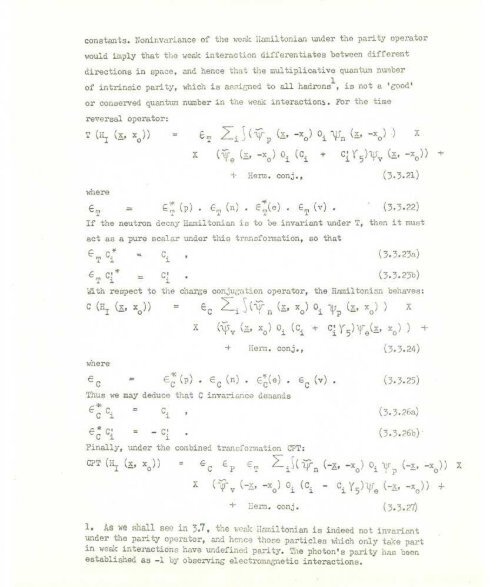introduction-weak-interaction-volume-one
introduction-weak-interaction-volume-one
introduction-weak-interaction-volume-one
You also want an ePaper? Increase the reach of your titles
YUMPU automatically turns print PDFs into web optimized ePapers that Google loves.
constants . Noninvariance of the <strong>weak</strong> Hamiltonian under the parity operato r<br />
would imply that the <strong>weak</strong> <strong>interaction</strong> differentiates between differen t<br />
directions in space, and hence that the multiplicative quantum numbe r<br />
of intrinsic parity, which is assigned to all hadrons l , is not a 'good '<br />
or conserved quantum number in the <strong>weak</strong> <strong>interaction</strong>s . For the time<br />
reversal operator :<br />
I r<br />
T (HI<br />
(x, xo)) - E T Zi ( p (x' - xo) 0 . -Y'n (x, -x o ) ) X<br />
where<br />
X ( '( r e (_, - xo ) O i (C i + cl)r 5)-yv (x, -xo)) +<br />
+ Hem . conj ., (3 .3 .21 )<br />
E T = E T ( p ) . e- T (n) . 0 (e) E T (v) . (3 .3 .22 )<br />
If the neutron decay Hamiltonian is to be invariant under T, then it mus t<br />
act as a pure scalar under this transformation, so tha t<br />
E T Ci =<br />
6 T Cl '~ =<br />
C i<br />
(3 .3.23a )<br />
Ci (3 .3 .23t )<br />
With respect to the charge conjugation o p erator, the Hamiltonian behaves :<br />
C ( HI (x, xo ) )<br />
E C ~ i j (Zl n (x, x o ) Oi 3Vp (2 x o ) )<br />
x<br />
X<br />
( v (-, x<br />
o ) 0i ( ci + c! r 5 )'r (x, xo) ) +<br />
+ Here . conj ., (3 .3 .24)<br />
wher e<br />
E C = F_c ( p ) . E c (n) . c(e) . 6 C (v) . (3 .3 .25 )<br />
Thus we may deduce that C invariance demand s<br />
G. * Ci = Ci (3 .3 .26a)<br />
E C<br />
C' = - Ci . (3 .3 .26b )<br />
Finally, under the combined transformation CPT :<br />
CPT (HI (x, x e )) = E c e p E T i 3(lir n (-x, - x o ) O i l r i ( -x, -xo )) X<br />
~<br />
X (-yry (-_,, -xo ) Oi (Ci - ci y 5 )1'Ie (-x, -x o )) i-<br />
+ Helm . conj. (3 .3 .27)<br />
1 . As we shall see in 3 .7, the <strong>weak</strong>. iamiltonian is indeed not invarian t<br />
under the parity operator, and hence those particles which only take par t<br />
in <strong>weak</strong> <strong>interaction</strong>s have undefined parity . The photon's parity has see n<br />
established as -1 by observing electromagnetic <strong>interaction</strong>s .



